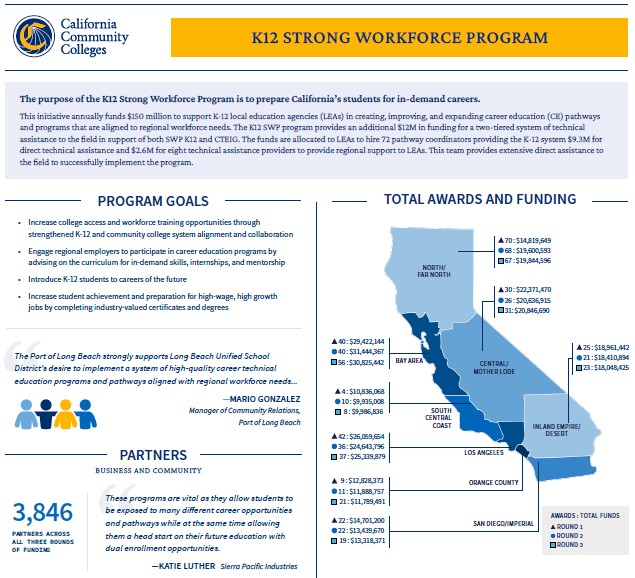In summer 2018, the California legislature introduced the K12 Strong Workforce Program (K12 SWP) as an ongoing statewide funding opportunity. It is designed to support K–12 local education agencies (LEAs) in creating, improving, and expanding career technical education (CTE) courses, course sequences, programs of study, and pathways for students transitioning from secondary education to postsecondary education to living-wage employment.
For any questions about the K12 Strong Workforce Program, please contact: K12SWP@cccco.edu.
-
K12 SWP Updates
The K12 Strong Workforce Program prepares California's students for in-demand careers. The most recent program updates are outlined in this one page infographic.
The primary objectives of K12 SWP are the following:
- To support essential collaboration across education systems between the K–12 sector and community colleges, or intersegmental partnerships, with involvement from industry businesses and organizations in strengthening CTE programs and pathways aligned with regional workforce needs
- To support LEAs in developing and implementing high-quality, K–14 CTE course sequences, programs, and pathways that:
- Facilitate K–12 student exploration and selection of learning opportunities leading to career paths
- Build foundational career path skills and knowledge essential to subsequent success in college and early career exploration
- Enable a seamless and successful transition from secondary to postsecondary education within the same or related career paths
- Lead to completion of industry-valued certificates, degrees, or transfers to four-year university or college
- Prepare students upon completion of education to enter into employment in occupations for which there is documented demand and which pay a livable wage
- Contribute toward meeting the projected need for one million completers of CTE programs aligned with the state’s labor markets
The K12 SWP initiative intentionally supports cross-system partnerships between K–12 and community colleges, or intersegmental partnerships, to develop an education and workforce development student pipeline through strengthened K–14 CTE course sequences, programs, and pathways. K12 SWP emphasizes vertical curricular alignment in K–14 CTE programs of study between LEAs and community colleges. The collaboration between secondary and postsecondary education serves to intentionally bridge two education systems that, as partners, can build capacity to provide high-quality CTE programs with coherent programming; integrated curriculum and instruction informed by regional economic needs; and the associated, longitudinal student data. These partnerships, along with involvement from industry businesses and organizations, support students’ successful transition from secondary education to postsecondary education to living-wage employment.
K12 SWP is the bridge that connects CTE programs at the K–12 level to their CTE counterparts at California community colleges, which have been focused on improving the availability and quality of postsecondary CTE programs through their own SWP funds since 2016–17. At the postsecondary level, SWP funds support eight California community college regional consortia. Per state legislation, community college districts and LEAs within each regional community college consortium annually engage in a regional planning process, resulting in their regional consortium’s SWP plan. Informed, in part, by the region’s labor market information, this plan drives the allocation of SWP funds. In sum, SWP supports both regional efforts to strengthen the education and workforce development student pipeline, as well as the community colleges’ efforts to improve CTE programs to lead students through their postsecondary education to living-wage employment in industries that reflect the region’s economic needs.
Contrastingly, K12 SWP funds are exclusively for the state’s K–12 LEAs. The K12 SWP incentivizes LEAs to partner with one or more community colleges or community college districts that are already immersed in strong workforce efforts. This cross-systems partnership enables the development of coherent programming in K–14 CTE programs of studies and pathways designed to support students’ upward mobility in the region’s industry sectors. The partnership also enables an LEA to use the partnering community college’s SWP funds as match funds, a requirement of K12 SWP.
California has committed to budgeting $150 million in ongoing, annual funds as an education, economic, and workforce investment to build an education pipeline that prepares highly skilled individuals to fill employment gaps in regional industries across the state. The California Department of Education and the California Community Colleges Chancellor’s Office, in partnership, manage the K12 SWP initiative and administer funds to eight California community college regional consortia, each of which forms a K12 Selection Committee that, guided by the regional priorities in the SWP regional plans, awards K12 SWP funds to eligible and qualifying LEAs in its region through a competitive grant process.
The state intends for LEAs to braid funds received from the K12 SWP with other financial sources—monies from the district’s Local Control Funding Formula, the state-funded Career Technical Education Incentive Grant (CTEIG), and/or the federally funded Strengthening CTE for the 21st Century Act (or Perkins V), to name a few—in complementary ways to implement successful CTE programs and pathways. In fact, California K–12 LEAs that currently support CTE courses, programs, or pathways and that are recipients of CTEIG funds and/or Perkins funds are encouraged to apply for a K12 SWP grant to leverage existing multiple funding streams for CTE implementation. LEAs without funds from CTEIG or Perkins V also are welcome to apply.
Both K12 SWP and CTEIG are state-based education, economic, and workforce development initiatives to support LEAs in creating, maintaining, or expanding CTE pathways. However, one key difference in their objectives is that K12 SWP requires LEAs to partner with at least one community college or community college district to create, strengthen, or expand K–14 CTE course sequences, programs, and pathways so that high school graduates can continue at the postsecondary level in the same course of study.
Both K12 SWP and CTEIG have a dollar-matching requirement for its grant recipients. Specifically, K12 SWP grant recipients that are a school district, a county office of education, or a charter school must provide matching funds to their grants in the amount of two dollars for every one dollar from K12 SWP; regional occupational centers and programs (ROCPs) have a 1:1 dollar matching requirement. SWP funds from the partnering community college or community college district count as match funds. The match funds for K12 SWP, however, cannot be from CTEIG, the California Career Pathways Trust, or other specific funding sources identified in the current K12 SWP Request for Applications. (More details about qualified financial match and in-kind match are described in the K12 SWP Request for Applications.)
Both K12 SWP and CTEIG funds are awarded through a competitive process. However, whereas CTEIG awards are decided by the California Department of Education, the K12 SWP grants are decided regionally. Within each of the eight regional community college consortia, a K12 Selection Committee reviews and awards applications through a regional competitive process. All LEAs requesting K12 SWP funds to create, implement, or expand CTE courses, programs, or pathways must demonstrate how their plans are aligned with the regional priority areas outlined in their regional consortium’s SWP plans and reflect the region’s workforce needs.
K12 SWP funds are an investment to support continuous improvement and capacity building. LEAs can choose to create new CTE courses, programs, or pathways; retool existing CTE programs with innovative practices; or expand current CTE courses, programs, and pathways that connect the K–12 sector with community colleges and local industry to improve student outcomes. K12 SWP funds are opportunity funds that help LEAs implement strategies that strengthen their CTE programming and support collaboration with local community colleges to extend education and career pathways for high school graduates. Strategies that improve college-going outcomes might include adapting K–12 CTE courses to meet “a–g” requirements, offering dual enrollment courses, or aligning a middle or high school CTE pathway to a community college’s existing career pathway. Other strategies that improve workforce outcomes might include establishing internships with local industries, utilizing industry expertise in secondary learning, or bringing industry staff to K–12 classrooms.
Eligible LEAs are school districts, county offices of education, charter schools, and ROCPs serving students in grades K through 12. (Specific eligibility requirements of ROCPs are described in the K12 SWP Request for Application.) Eligible LEAs submit an application to the California Community Colleges Chancellor’s Office, which disseminates the applications to the appropriate region’s K12 Selection Committee. Per state legislation, each regional K12 Selection Committee comprises individuals with expertise in K–12 CTE or workforce development, including K–12 CTE teachers and administrators, charter school representatives, career guidance counselors, industry representatives in the region’s priority areas, and at least one community college faculty member or administrator. Through a competitive grant process, K12 Selection Committee members review and score applications using the K12 SWP rubric before deliberating to select the final recommended list of awarded applicants.
At the direction of the K12 SWP legislation, a set of metrics are used in evaluating the K12 SWP. These outcomes show student success in secondary and postsecondary education and in the workforce. The secondary education metrics measure:
- student completion of two or more CTE courses in high school in the same program of study;
- completion of two or more CTE courses that include early college credit, work-based learning, or third-party certification;
- high school graduation rate; and
- enrollment in a California community college within one year of high school graduation
Grant recipients are required to allow CALPADS to share student data with Cal PASS Plus and to provide additional data necessary to populate these metrics.
This next section provides guidance for strengthening K–14 CTE pathways through cross-system partnerships, such as the secondary education and postsecondary education partnership required for K12 SWP.
The Guiding Policy Principles to Support Student-Centered K–14+ Pathways (Guiding Policy Principles) were developed by the California Workforce Pathways Joint Advisory Committee and approved in May 2019 to guide practices that support cross-system collaboration for strengthening K–14 college and career pathways, especially as current and future funds from the state and federal government continue to support such cross-system collaborative efforts. The complete Guiding Policy Principles can be accessed at the California Department of Education website.
Following are the five Guiding Policy Principles in abbreviated statements with examples of practices aligned to each of these principles.
- Focus on a student-centered delivery of services for all K–14+ college and career pathways
- Provide multiple pathway options in one industry that lead to different outcomes: an industry-valued certificate, an associate’s degree, a transfer to a four-year university or college. Increase engaging learning experiences for students.
- Promote equity and access by eliminating institutional barriers and achievement gaps for all students to realize their educational and career aspirations
- Provide dual enrollment classes, which give students access to earning college credits while still in high school, contribute to on-time postsecondary graduation, and reduce college fee expenses.
- Actively reach out to first-generation, college-going students to provide college and career counseling and guidance; offer in languages other than English.
- Achieve cross-system alignment in the state’s economic regions in order to create a comprehensive and well-defined system of articulation of high-quality K–14+ pathway courses.
- Use labor market data to strategically develop sector-based programs for the region and create a system for directing qualified students to employment in the region. Through the regional planning process, evolve a portfolio of K–14 CTE pathways that align K–12 and community college CTE programs with each other and with the opportunities the regional economy provides for livable wage employment.
- Support the continuous improvement and capacity building at all levels and components.
- Appropriately use data to understand equity and access for all students. (For instance, use CTE LaunchBoard data to understand which student subgroups are and are not reaching completion, or to understand which CTE pathways are leading to employment in the region. Follow up by modifying pathways to improve student success.)
- Ensure that state priorities and direction lead the state plan by leveraging opportunities in Perkins.
- Assist in accomplishing the state goals and objectives for student achievement of English learners, students eligible for free and reduced meals, and foster youth through intentional outreach and support to these student populations.
Efforts of any K–12 LEA and community college partnership proposed through the K12 SWP will vary, depending on factors that include pre-existing CTE programs, local and regional economic needs, and capacity. Following is one example of how such a partnership can strengthen and expand a K–14 career education pathway through K12 SWP and other CTE resources.
A rural high school located in California’s Central Valley currently offers CTE courses such as Career Exploration in Agriculture, Welding Technology, and Agriculture Leadership & Technology. Its district received K12 SWP funding to improve its agriculture-related CTE programs. To learn how their high school students can continue and deepen their career and technical education, one CTE teacher and the district CTE coordinator met with the career education dean at the local community college. They learned about the college’s Agriculture Mechanics Pathway, which was developed with support from the National Science Foundation and the local workforce development agency, whose labor market data revealed a dearth of qualified skilled workers in the region to support the growing agriculture industry sector. At this community college, interested students can choose to enter many agriculture-related pathways and complete their course of study with an irrigation technology certificate, an associate’s degree in agricultural mechanics, or an associate’s degree in agriculture business.
The high school CTE team chose to use the K12 SWP opportunity to expand its CTE courses into several agriculture and natural resources pathways that would seamlessly guide its secondary students into established pathways at the community college. To start, the secondary CTE team is focusing on developing an Agriculture Mechanics Pathway at the high school, including articulated courses with the community college. Additionally, the CTE team has consulted with industry experts to develop an Agriculture Science Pathway, which now offers “a–g”-approved science courses through an agricultural lens, such as agricultural biology, agricultural chemistry, and food science. The objective of these new CTE pathways is, ultimately, to lead its students into an industry with job opportunities offering family-supporting wages after completing their postsecondary education.
As the high school expands its CTE program, it leverages different funding and match sources strategically: the Local Control Funding Formula is budgeted for the hiring of a new CTE teacher; CTEIG supports professional development and purchase of new agriculture-related equipment; Perkins V supports work-based learning opportunities; the partnering community college’s SWP match includes student outreach for CTE programs and CTE team collaboration; while K12 SWP supports teacher planning time to modify the “a-g” curriculum with an agricultural lens.
The collaboration between the high school and the community college is responsible for the new K–14 agriculture pathways that offer students a coherent program from high school through college. High school students experience real-world learning and explore career opportunities in their CTE pathways before continuing to advance their education and skills at the community college, where they enter on a known path from the start.


